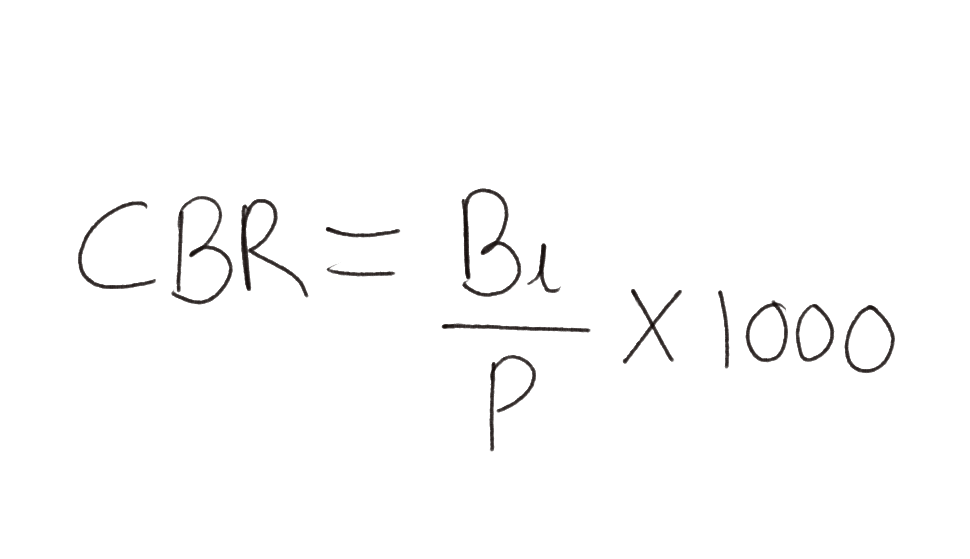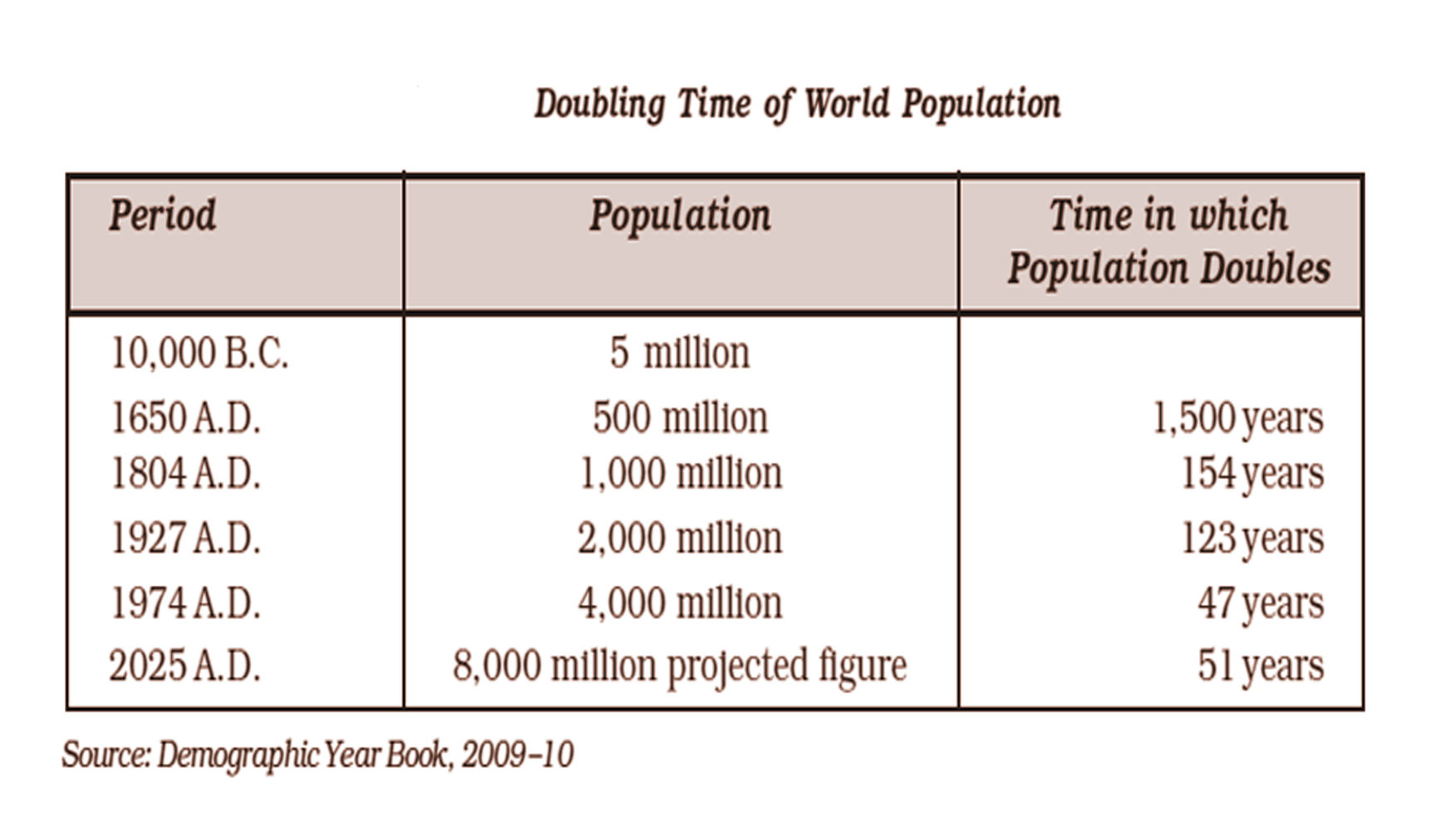Growth of Population: Change of population in a particular area between two points of time are known as growth of population. For example, if we subtract the population of the UK 2001 (5.1 crores) from the population of 2011 (6.32 crores), then we shall get the growth of population (1.22 crores) in actual numbers.
Growth Rate of Population: This is the difference between population represented in percentage.
Natural Growth of Population: It is the population grown by the difference between deaths and births in a certain region between two points of time.
Natural Growth = Births – Deaths
Actual Growth of Population: Births – Deaths + In Migration – Out-Migration
Positive Growth of Population: It happens when the birth rate is higher than the death rate between two points of period or when people from other nations migrate permanently to a country.
Negative Growth of Population: If the population declines between two points of time it is called negative growth of population. It happens when the birth rate drops below the death rate, or people move to other nations.
Components of Population Change
There are three elements of population change – births, deaths and migration. The crude birth rate (CBR) is represented as the number of births (live) in a year per thousand of population. It is estimated as:
Here, CBR = Crude Birth Rate
Bi = live births during the year
P=Mid year population of the area.
Death rate performs a vital role in population change. Population growth happens not only by rising births rate but also due to the declining death rate.
Crude Death Rate
CDR is a simplistic approach to estimating the mortality of any area. CDR is represented in terms of the number of deaths in a particular year per thousand of the population in a certain area.
CDR is calculated as:
Here, CDR=Crude Death Rate
D = Number of deaths
P = Estimated mid-year population of that year.
By and large mortality rates are influenced by the region’s demographic composition, social progress and levels of its economic expansion.
MIGRATION
Apart from death and birth, there is another way by which the population size varies. When people migrate from one region to another, the place they leave is called the Place of Origin and the place they migrate to is called the Place of Destination. The place of origin shows a drop in population while the population swells in the area of destination.
Migration may be deciphered as a spontaneous attempt to achieve a better balance between resources and population.
Migration may be temporary or seasonal and permanent. It may take place from rural to urban areas, rural to rural, urban to rural and urban to urban areas.
Do you recognise that the same individual is both an immigrant and an emigrant?
Immigration: Migrants who shift to a new place is called Immigrants.
Emigration: Migrants who move out of the place is called Emigrants.
People migrate for better financial and social life. There are two factors that control migration:
- The Push factors are factors that make a place of origin seem less charming. It could be due to unemployment, political turmoil, poor living conditions, unpleasant climate, epidemics, natural disasters, and socio-economic backwardness.
- The Pull factors are factors that make the place of destination seem more engaging than the place of origin. It can be due to reasons like better job opportunities and living conditions, peace and stability, the security of life and property, peace and stability and agreeable climate.
TRENDS IN POPULATION GROWTH
The population on earth has increased to more than seven billion. It has grown to this extent over centuries.
In the early periods’ population of the world increased very slowly. It is only during the latest century that the population has risen at a dangerous rate.
After the development and introduction of agriculture about 12,000 to 8,000 years ago, the size of the population was modest – approximately 8 million. In the Ist century A.D., it was under 300 million. The expanding world commerce during the 16th and 17th century set the stage for fast population growth. Around 1750, at the advent of the Industrial Revolution, the world population reached around550 million. World population erupted drastically in the 18th century after the Industrial Revolution. Technological progress accomplished so far assisted in the lowering of birth rate and presented a stage for accelerated population growth.
DOUBLING TIME OF WORLD POPULATION
It took around a million years for the human to achieve the one billion mark. But in only 12 years it rose from 5 billion to 6 billion.
There is a large disparity among countries in doubling their population. Developed countries take more time to multiply their population as opposed to developing countries. Most of the population growth is occurring in the developing world, where the population is blasting. Why is this so?
SPATIAL PATTERN OF POPULATION CHANGE
Population growth in various parts of the world can be analysed. The growth of the population is moderate in developed countries as compared to developing countries. There is a negative relationship between economic growth and population growth.
Although the yearly rate of population change (1.07 per cent) seems to be low, it is actually not so. This is because:
- When this tiny annual rate is implemented to a very large population, it will lead to a massive population change.
- Even if the growth rate continues to decrease, the total population increases each year. The infant mortality rate may have improved as has the death rate during childbirth.
IMPACT OF POPULATION CHANGE
A modest increase in population is welcome in a flourishing economy. However, population growth beyond a certain level heads to problems. Of these, the exhaustion of resources is the most serious. Population drop is also a matter of concern. It intimates that resources that had sustained a population earlier are now inadequate to support the population.
The fatal HIV/AIDS epidemics in Africa and some parts of the Asia and Commonwealth of Independent States (CIS) have forced up death rates and decreased average life expectancy. This has reduced population growth.
DEMOGRAPHIC TRANSITION
Demographic transition theory can be used to explain and forecast the future population of any area. The theory tells us that the population of any area changes from high deaths and high births to low deaths and low births as society advances from a rural agrarian and uneducated to urban industrial and educated society. These shifts transpire in stages which are collectively known as the demographic cycle.
- The first stage has high mortality and high fertility because people generate more to counterbalance the deaths due to epidemics and unsteady food supply. The population growth is sluggish and most of the people are employed in agriculture and families with a large number of individuals are an asset. Life expectancy is very low; people are mostly uneducated and have lower levels of technology. Two hundred years ago all the nations of the world were at this stage.
- Fertility remains high at the beginning of the second stage, but it declines with time. This is characterised by a decreased mortality rate. Advancements in health and sanitation conditions lead to a drop in mortality. Because of this gap, the net gain to the population is raised.
- In the last stage, both mortality and fertility drop considerably. The population is either grows slowly or become stable. The population becomes urbanised, educated and has the high technical know-how and intentionally manages the family size. This shows that human beings are greatly flexible and can adjust their fertility. Today, different countries are at different stages of the demographic shift.
POPULATION CONTROL MEASURES
Family planning is the spacing or limiting the birth of children. Access to family planning service is an important factor in checking population growth and enhancing women’s health. Advertisement, free availability of contraceptives and tax disincentives for large families are some of the measures which can help population control.
Thomas Malthus in his theory (1798) asserted that the number of people would rise faster than the food supply. Any further expansion would result in a population crash induced by famine, disease and war. The precautionary checks are better than physical checks. If we want to sustain our resources, the world will have to check the rapid population expansion.
Frequently Asked Questions
Define population and demography.
Population refers to the total number of people in a specific area, while demography is the study of population characteristics, such as age, gender, and migration.
What is the significance of the demographic transition model in understanding population growth?
The model illustrates how populations change over time, shifting from high birth and death rates to low rates as countries develop. It helps predict future population trends.
Explain the concept of population pyramids and how they represent age and gender distribution.
Population pyramids are graphical representations that show the distribution of population by age and gender, providing insights into a population’s structure.
How does net migration contribute to changes in a population’s size and composition?
Net migration is the difference between immigration and emigration. It can significantly impact a country’s population growth and demographics.
The dependency ratio compares the economically dependent population (e.g., children and elderly) to the working-age population. It helps assess the support burden on the workforce.










